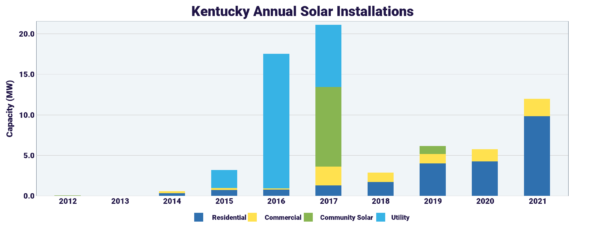The pv magazine USA tour of solar incentives state by state now moves from the south Atlantic states and into the east south central region, stopping off in Kentucky.
Kentucky, which ranks 26th in population in the United States, ranks 46th in solar installations, according to the Solar Energy Industries Association. With just 78 MW installed, or enough to power just over 7,500 homes, there’s much PV opportunity in the Bluegrass State. However, according to SEIA, the state is on track to install only 1,594 MW over the next five years, dropping it to number 30 in the country.

With electricity cost currently at just 13.24 cents per kWh (according to EIA data), residents and business owners don’t have as much incentive as in states with much higher electricity costs. Financial incentives for Kentucky residents to go solar are currently few and far between.
Kentucky does not have a renewable portfolio standard, nor does it have a voluntary renewable energy target. The status of net metering now varies depending upon the utility, but traditional 1:1 net metering remains in effect for much of the state. Rates are set by the Public Service Commission (PSC) in rate cases brought by each utility. To-date, only LG&E, KU, and KY Power Company have applied to change their net metering rates.
Energy communities
Help is on the way thanks to the recently passed Inflation Reduction Act (IRA) offers commercial solar and energy storage projects up to 10% additional tax credit for projects built within an “energy community”, which is defined as an area that, after 2000, had “significant employment related to the extraction, processing, transport, or storage of coal, oil, or natural gas,” and as a “census tract in which after 2000, a coal mine has closed, or after December 31, 2009, a coal-fired electric generating unit has been retired, or which is directly adjoining to any census tract described in subclause.”
While Kentucky was a leading coal producing state, that industry has fallen on hard times. For example, at the end of 2011, nearly92,000 people were employed in the U.S. coal industry, but by 2016, that number had dropped to 51,800. Since 2012, more than 60 coal companies have filed for bankruptcy or liquidation. In 2020, the Covid-19 pandemic delivered another shock, with a further 7,000 jobs being shed by the coal industry that year. Needless to say, Kentucky is rife with “energy communities” that can take advantage of the incentives from the IRA.
Landmark projects
Under development by Savion, the Martin County Solar Project is a 200 MW solar project being constructed on 1,200 acres of the former Martiki coal mine site in Martin County, near the Kentucky-West Virginia border. Construction of the facility is expected to begin this year and it is expected to achieve commercial operation early 2024. The project is the largest in Kentucky known to pv magazine, unseating the former record holder, ACCIONA’s 188 MW Fleming County Solar Project, currently under construction.
To spur further investment, some utilities, such as TVA, offer programs. TVA’s Green Investment Program aims to help businesses, industry and municipalities to meet their sustainability goals. General Motors and Facebook both signed up as offtakers for a solar-plus-storage project in Southern Kentucky.
The last stop on the pv magazine tour of the 50 states of solar incentives was Florida, and next we will continue onto Tennessee.
This article was amended on Nov. 4, 2022 to update the net metering information, with new information provided by Andy McDonald, director, Apogee, Climate & Energy Transitions
This content is protected by copyright and may not be reused. If you want to cooperate with us and would like to reuse some of our content, please contact: editors@pv-magazine.com.









By submitting this form you agree to pv magazine using your data for the purposes of publishing your comment.
Your personal data will only be disclosed or otherwise transmitted to third parties for the purposes of spam filtering or if this is necessary for technical maintenance of the website. Any other transfer to third parties will not take place unless this is justified on the basis of applicable data protection regulations or if pv magazine is legally obliged to do so.
You may revoke this consent at any time with effect for the future, in which case your personal data will be deleted immediately. Otherwise, your data will be deleted if pv magazine has processed your request or the purpose of data storage is fulfilled.
Further information on data privacy can be found in our Data Protection Policy.